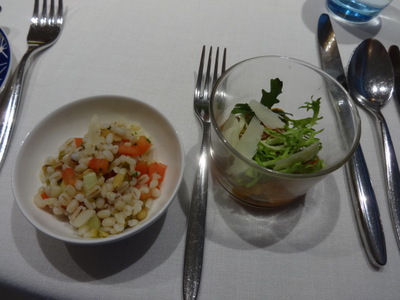
 The fine-print appetizers were a small barley salad and a little salad of frisée and tomatoes with flakes of Parmesan.
The fine-print appetizers were a small barley salad and a little salad of frisée and tomatoes with flakes of Parmesan.Thursday, 29 September, Budapest, Hungary (unicum and chocolate)
Written 30 November 2022
This morning, on the breakfast buffet, I couldn't believe my eyes! Canary melon! I first encountered canary melon on our very first Viking cruise, in Portugal in 2015. It's the color an shape of a large spaghetti squash, and the flesh is so white it looks like potato. And in Portugal in September, it was in season, and it was everywhere! It was served at most meals, both on the Viking ship and in our meeting hotel, and I loved it. It didn't even upset my digestion the way cantelope or honeydew can.
Just once since that time it showed up in my local supermarket here in Tallahassee. I immediately bought one and served half of it, to great acclaim, at a dinner party. Unfortunately, David doesn't eat melon, and we were leaving town the following day, so I gave the remaining half to our dinner guests. Although I look for it every time I shop, it has never reappeared.
Now, again in September in Europe (and with Viking), I hoped to encounter it again, but this was the first time (and alas the last) it appeared. I ate lots of it but wished afterward that I had stashed some in my stateroom's minifridge for later.
The ship had relocated during the previous evening, but we were still moored on the Pest side, sandwiched between two other Viking ships, the Ingve between us and the shore and the Var on the outside. Rain was predicted for that day, but it looked as though it was already clearing up at 10:30 am.
Since we arrived in Budapest, river traffic has increased dramatically from what we've seen so far. Cruise ships are everywhere, and so are tugs, barges, and other commercial traffic.
As I concluded from the unexpected directions our earlier excursions took, Viking has been fiddling around with the schedules. Because we had already seen the Hungarian horsemen, originally scheduled for this day, we were given the option to cancel that booking and choose another option. The only morning possibility was "Budapest Castle Hill City Hike," but we'd seen how steep that hill is, and when Viking calls something a "hike" they mean it's strenuous, so we passed on that one. For the afternoon, I was tempted by the tour of the synagogue and "Jewish Budapest," but a new excursion had appeared that appealed even more: Hungarian Icons. We had only a small group—eight or so— so I suspect many people took one look at the title and concluded it would be a tour of painted religious images with gold backgrounds. But I read the fine print and could see that we would instead be touring a factory that made an iconic brand of Hungarian bitters and another that made fine chocolates. They should change the name of the excursion to something like "Iconic Hungarian Products."
So I once more amused myself until lunch time by working on this diary, triaging my photos and transcribing my recorded notes.
Written 3 December 2022

 The fine-print appetizers were a small barley salad and a little salad of frisée and tomatoes with flakes of Parmesan.
The fine-print appetizers were a small barley salad and a little salad of frisée and tomatoes with flakes of Parmesan.
David started with the Caesar salad from the always-available menu.
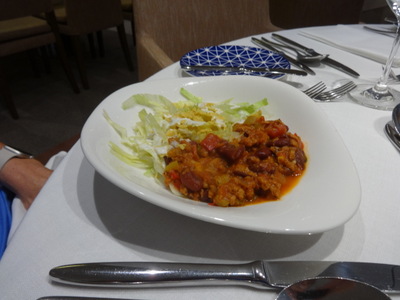
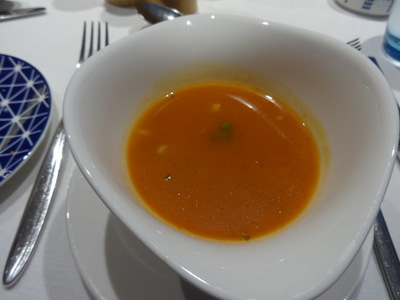 Jan ordered the vegan taco bowl (left), and I started with the red bell pepper soup. It supposedly came with jalapeño salsa, but I didn't notice any.
Jan ordered the vegan taco bowl (left), and I started with the red bell pepper soup. It supposedly came with jalapeño salsa, but I didn't notice any.
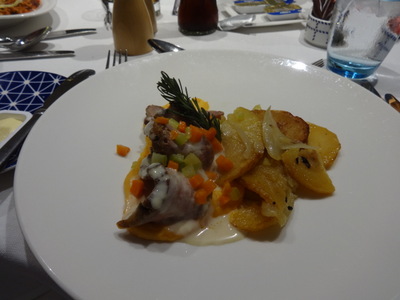
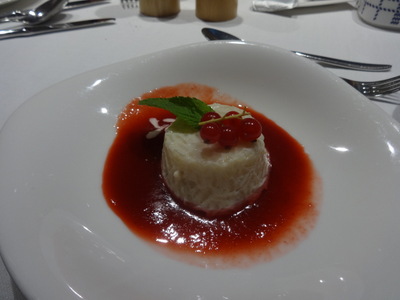 My main course was roast veal with sautéed potatoes, onions, and pumpkin mousseline.
My main course was roast veal with sautéed potatoes, onions, and pumpkin mousseline.
For dessert, I tried the vanilla rice pudding with strawberry sauce, which came garnished with a spray of lovely red currants. It was good, but a little too solidly congealed for my taste.

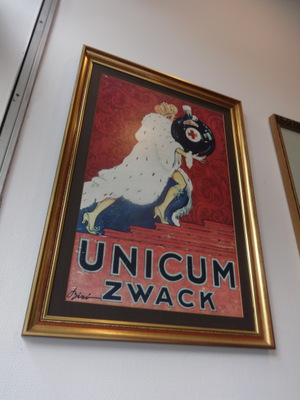 David had the caramel sundae with almonds, which was just what it sounded like.
David had the caramel sundae with almonds, which was just what it sounded like.
Written 14 December 2022
Once again, we were met on the dock by our local guide for the day. On previous cruises, we have been accompanied on all excursions by a "tour escort," a Viking employee who took us to whatever we were touring, usually in a Viking vehicle, and handed us over at the site to a local guide, then trailed along with us. On this trip, there have been no tour escorts. Our local guides come to the ship, usually in a locally hired vehicle, and brings us back afterward. Probably the result of the pandemic—Viking took a real financial hit and has probably had to streamline its operation in places. Another example is the lunchtime appetizer buffet, alas gone and replaced by the fine-print appetizer.
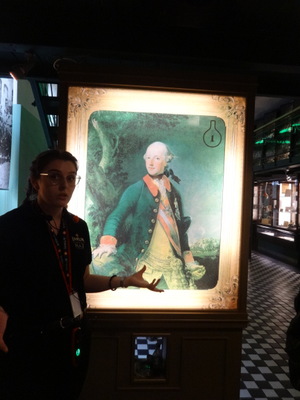
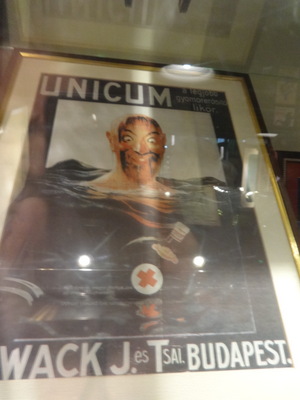 Our first stop was the factory that produces an iconic Hungarian brand of bitters/liqueur, renowned as a digestive. Back in 1790, Holy Roman Emperor Josef II (shown here at the left), had digestive problems, so he asked his physician, Dr. József Zwack, for advice and help. Dr. Zwack gave him an herbal extract that he concocted for the purpose. The emperor swigged it down, immediately felt better, and pronounced "Das is ein Unicum!" (meaning, I think, "This is a unique thing!")
Our first stop was the factory that produces an iconic Hungarian brand of bitters/liqueur, renowned as a digestive. Back in 1790, Holy Roman Emperor Josef II (shown here at the left), had digestive problems, so he asked his physician, Dr. József Zwack, for advice and help. Dr. Zwack gave him an herbal extract that he concocted for the purpose. The emperor swigged it down, immediately felt better, and pronounced "Das is ein Unicum!" (meaning, I think, "This is a unique thing!")
In 1840, Dr. Zwack's son, József Jr., formed a company, with his brother János, to manufacture it and called it Zwack's Unicum.
At the right is their most popular advertising image, the "water man"—a dripping, pointy-eared guy's head popping up out of the water smiling covetously at a bottle of Unicum. For some reason, many websites refer to this image as the "drowning man," but the Zwack guide always said "water man," and the image gives no impression that he's drowning.
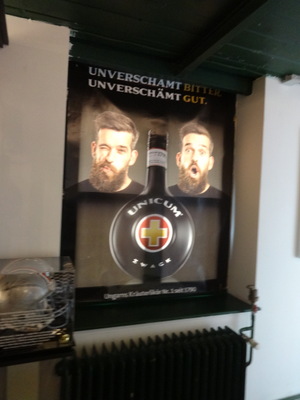
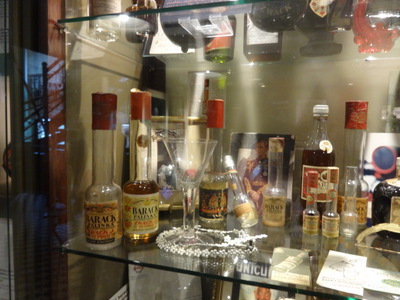 At the left here is another of their advertising images. It shows a little more clearly the characteristic round, flat shape of the bottle, with a short neck.
At the left here is another of their advertising images. It shows a little more clearly the characteristic round, flat shape of the bottle, with a short neck.
In the display case shown at the right (one of many in the Zwack company museum), are bottles of another of the company's products Barack brand palinka (a fruit brandy); pallinka is to Hungarians what vodka is to Russians. The glasses in which it is served echo the shape of the bottle (not the large tulip-shaped glass, but the right-most in the row of smaller bottles), a cylinder with a narrower cylindrical neck. Café patrons who had trouble attracting the waiters' attention soon found they could call for refills by blowing across the top of the empty glass, so the product came to be called "whistling palinka."

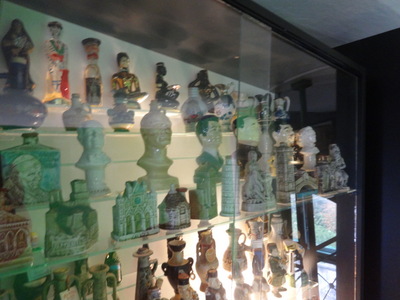 The museum included a lot of artifacts from the company's history, as well as family photos and examples of it's many other products. The whole mezzanine was taken up with their collection of 17,000 miniature liquor bottles. To take the photo at the left, I stood at one end of the mezzanine and looked down the length of it toward the other end. Each of the lighted bays you see holds five back-lighted shelves, each holding about 20 little bottles.
The museum included a lot of artifacts from the company's history, as well as family photos and examples of it's many other products. The whole mezzanine was taken up with their collection of 17,000 miniature liquor bottles. To take the photo at the left, I stood at one end of the mezzanine and looked down the length of it toward the other end. Each of the lighted bays you see holds five back-lighted shelves, each holding about 20 little bottles.
The photo at the right is a closer view of one of the cases holding miniature bottles in the shape of something—Grecian urns, cartoon musicians, political figures, buildings, all kinds of things.
In the gift shop, you could buy Zwack light bulbs and string lights.
Also in a corner of the mezzanine was a green-screen set-up where you could select your background, then pose for the camera, inserting yourself into, e.g., a Unicum advertising poster! In the background while we toured the museum was a video screen running Unicum (and other Zwack product) TV ads. Some showed a hot-air balloon in the shape of a Unicum bottle, floating over the alps with a raft of other balloons. An especially good one featured the Hungarian Olympic swimming team being encouraged forward by a large and extremely realistic CGI sturgeon!
The history of the company and of the family is complicated. The founder died in 1915. In 1922, the Red Cross sued them for using a red cross on their bottles, so at that point, they switched to a gold cross.
The Zwacks were Jewish, so WWII was not good. They couldn't even convert (either sincerely or pro forma) because your family's Christianity had to be back six generations. One of the daughters of the family had a country villa, and the rest of the family fled and hid out there. The neighbor was a Swedish diplomat who forged Swedish passports for them and got them out of the country eventually.
The distillery building was solid, so it was used as an air-raid shelter. It marks the divide between before and after the war. After WWII, the whole operation was nationalized. The founder's grandson Bela handed over a fake version of the recipe, and he and his family stayed on, supervising production of the fake stuff.
Another descendent was sent to a concentration camp but managed to get away. Another (Peter, I think, a grandson of the founder) escaped from the country with the genuine secret formula. He got off the train before the border and walked all the way to Italy. Then he emigrated to the U.S. and settled down there. He brought his wife and mother over. They set up a foundation to raise money for the Hungarian refugees from the failed 1956 revolution.
Peter's American children did not inherit the company—his father's will specified that whoever did had to move to Hungary and learn the language, and they chose not to, but that branch remains on very good terms with the rest of the family. One came over and worked as an English-language tour guide at the factory for a while.
Peter came back to Italy, married again there, and produced two children who became the current successors to the company. Grandson Sandor, born in Italy, speaks many languages, has come back and is now head of the board of directors.
During the communist period, Zwack managed to get the Cocoa Cola bottling contract for Hungary. Once communism ended, original owners of national property were able to buy it back, which the family did, with the help of a silent partner. They gradually changed the fake Unicum flavor back toward the original and finally discontinued the fake version entirely. The company is now traded publicly.
Isabella Zwack, also born in Italy, has a winery in the Tokay region and makes wine there.
I hope I haven't garbled the family history too badly!

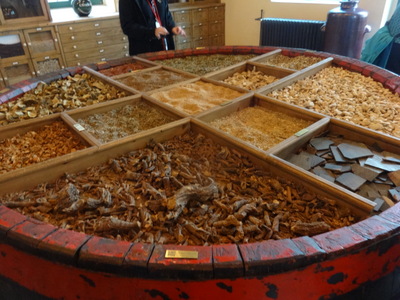 From the museum, we crossed a brick courtyard, under a light drizzle, to the original manufacturing plant (well, original since 1892, not the original original). On the wall there was the flow chart shown here at the left. It demonstrates how Unicum is produced from a mixture of over 40 different plant parts. The secret combination of ingredients is macerated in cold alcohol and water while the same ingredients are macerated separately in a hot mixture. The alcohol used to be produced on the premises but is now made elsewhere, mostly from corn. The hot and cold preparations are mixed, liquid sugar is added, and the combination is aged 3 months in oak. Then it's put into smaller barrels and aged another 3 months. Finally, it's filtered, then taken by tank truck to a plant elsewhere for final bottling.
From the museum, we crossed a brick courtyard, under a light drizzle, to the original manufacturing plant (well, original since 1892, not the original original). On the wall there was the flow chart shown here at the left. It demonstrates how Unicum is produced from a mixture of over 40 different plant parts. The secret combination of ingredients is macerated in cold alcohol and water while the same ingredients are macerated separately in a hot mixture. The alcohol used to be produced on the premises but is now made elsewhere, mostly from corn. The hot and cold preparations are mixed, liquid sugar is added, and the combination is aged 3 months in oak. Then it's put into smaller barrels and aged another 3 months. Finally, it's filtered, then taken by tank truck to a plant elsewhere for final bottling.
At the right is a large barrel head divided into labeled compartments displaying some (but not all) of the "botanicals" that go into the mixture. And as a further security measure, some extra ingredients are displayed that are not used in the product. The guide assured us that she did not know which were which. Only the head of the company knows the entire formula.
Some of the items displayed were angelica root, dried orange peel, colombo root, bogbean, dried rose petals, dill seed, cardamom pods, orris root, celery seed, guajak tree (yes, chips of wood), and mustard seed. The guide said that she knew the colombo root was definitely used in the company's colombo gin.
In the same room, she showed us a huge green tank that I think was where the hot maceration was originally done, as well as four-foot-high stone crocks in which the cold maceration was originally done. They are still where they stood while in use.
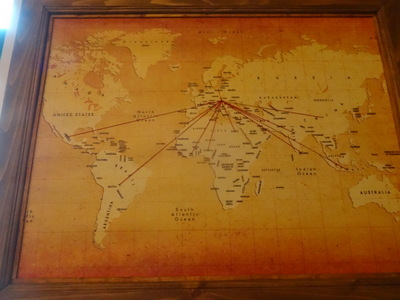
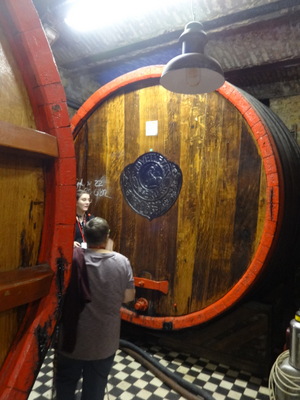 On another wall was this map of the world with red threads stretching from Budapest out to all the locations from which the plant flavorings are collected.
On another wall was this map of the world with red threads stretching from Budapest out to all the locations from which the plant flavorings are collected.
She then took us down an iron stairway to the basement, which is 500 square meters and contains 113 barrels. Each of the barrels like the one in the photo holds 1000 liters. The barrels are not changed; they use the same ones indefinitely. Some are 70 or 80 years old. The seal on the one in the photo says "1837." No Unicum remains from before the war, because the Germans drank it all.
A substance called "black honey" builds up on the inside of the barrels; they use it to flavor a "sweet" variety of Unicum ("sweet" being a relative term). The original is still used as a digestive medicine, sometimes neat and sometimes with a beer or other chaser. But Unicum now comes in several varieties and flavors. The first variant was mint flavored. The most recently introduced (in 2020) is "barrista," flavored with coffee (they add 100% arabica extract at the cold-maceration stage; she said it contains about 1/6 the caffeine of actual coffee). We tasted the original and the plum flavor (the latter is only 343.5% alcohol). To make the latter, they fill a barrel one-third full of prunes, fill it up with Unicum, then age it like that. I like it better than the original (though, surprisingly, I sort of liked the original, too). It was reminiscent of Vick's Formula 44. You can see all the options at unicum.com.
The barrels are color coded. Red is original, gold is plum, brown is coffee. Isabella's winery in the Tokay region supplies the barrels they use to make "riserva," which debuted in 2016 and is apparently aged 6 months in the oldest barrels with the black honey and (I think she said) the sweetest available dessert wine.
A bottle of riserva is 49 euros in the market hall; here at the factory, it's half the price.
From the Zwack factory, we had only a short bus ride to a spot from which we could easily walk to our next stop past the famous parliament building.
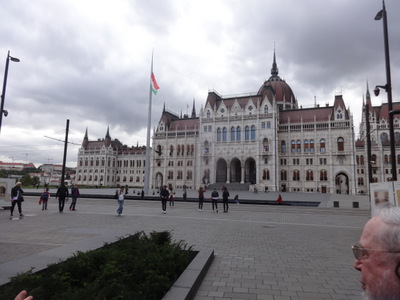
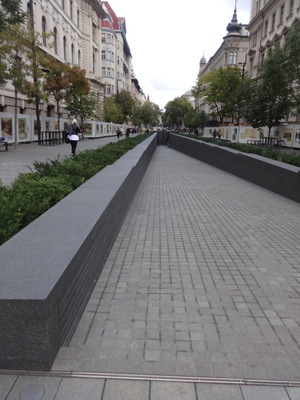 Here, at the left, is the parliament building from the inland side, the side away from the river. As we walked, the guide told us that Hungary lost 69% of its territory after WWI. The territories lost were "almost 100% Hungarian," by which I guess she meant that they were ethnically or linguistically Hungarian. Near the parliament is a monument (shown here at the right) on which a long list of town names are written on a pair of low walls, as a memorial of what they lost. Transylvania was the largest Hungarian territory and is now part of Romania. Hungary flies the Transylvanian flag on the Parliament building rather than the union flag, and Hungary and Romania still have no diplomatic relations.
Here, at the left, is the parliament building from the inland side, the side away from the river. As we walked, the guide told us that Hungary lost 69% of its territory after WWI. The territories lost were "almost 100% Hungarian," by which I guess she meant that they were ethnically or linguistically Hungarian. Near the parliament is a monument (shown here at the right) on which a long list of town names are written on a pair of low walls, as a memorial of what they lost. Transylvania was the largest Hungarian territory and is now part of Romania. Hungary flies the Transylvanian flag on the Parliament building rather than the union flag, and Hungary and Romania still have no diplomatic relations.
The parliament building was the winner of a design contest. The second and third place winners were also constructed, behind the parliament. They house the Supreme Court and the Ministry of Agriculture.
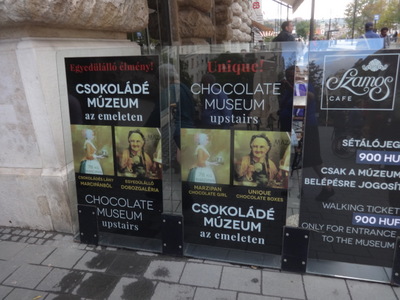
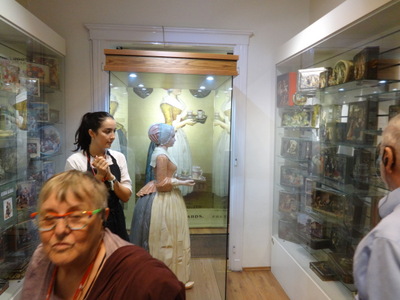 The photo at the left here is the sign outside our next stop, the Szamos Chocolate Shop and Museum, where we were greeted and taken in hand by their local guide. The shop is downstairs and the museum upstairs. At the top of the stairs we found a "cocoa tree," a six-foot (dead) tree spray-painted gold and hung all over with gilded plastic cocoa pods.
The photo at the left here is the sign outside our next stop, the Szamos Chocolate Shop and Museum, where we were greeted and taken in hand by their local guide. The shop is downstairs and the museum upstairs. At the top of the stairs we found a "cocoa tree," a six-foot (dead) tree spray-painted gold and hung all over with gilded plastic cocoa pods.
At the right is something I wish I'd gotten a better photo of. Apparently when coffee was first introduced to Europe, serving it because a huge ritual and status symbol, to th epoint where wealthy households employed a "coffee waitress," whose only job was preparing and serving coffee in tall chocolate pots, like tall coffee pots. Sugar was added and a mollinette to mix it. In the photo, you'll see three figures—in the foreground, a member of our group, behind her our guide, and beyond that, in a glass case a three-dimensional, life-size, quite realistic replica of a coffee waitress. The remarkable thing about the coffee waitress is that she is made entirely of 170 pounds of marzipan! The guide made us guess the only two items in the case that are not made of marzipan—the glass of water on her tray (nobody has yet produced transparent marzipan) and her eyelashes.
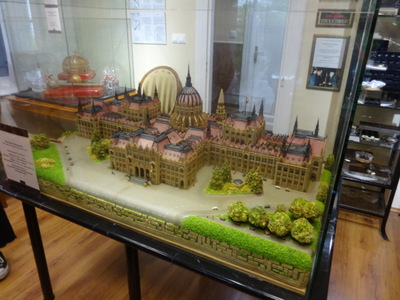
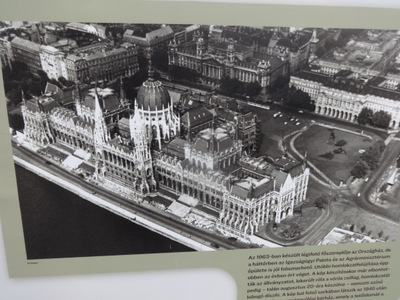 At the left here is another work by the same artist. A detailed scale model of the parliament building, made entirely of marzipan (the only other item is the green tinted coconut she used for the grass).
At the left here is another work by the same artist. A detailed scale model of the parliament building, made entirely of marzipan (the only other item is the green tinted coconut she used for the grass).
Compare the historic photo of the building shown at the right. It's taken from the river side, whereas the model is from the inland side, but still . . .
The museum included rooms filled with antique chocolate molds (once metal, then bakelite, and now plastic), antique chocolate boxes, and antique chocolate preparation equipment.
We got to eat plain roasted cocoa beans, which I expected to be very bitter, like unsweetened baking chocolate, but they were just pleasantly nutty. Maybe they didn't seem very bitter after the liqueur we just had.
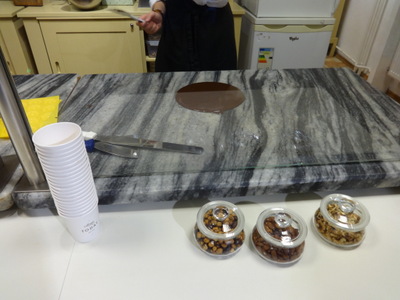
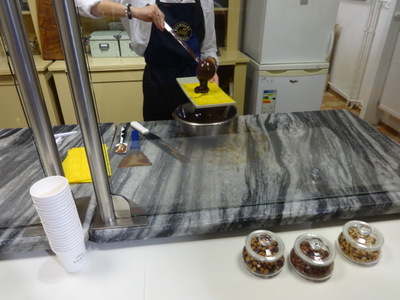 Finally, we came to the demonstration kitchen. Our guide poured a pool of hot (114
Finally, we came to the demonstration kitchen. Our guide poured a pool of hot (114
She then scooped it up and used it to fill the indentations in a flimsy plastic mold to make little flat stylized-flower-shaped pastilles (photo at the right).
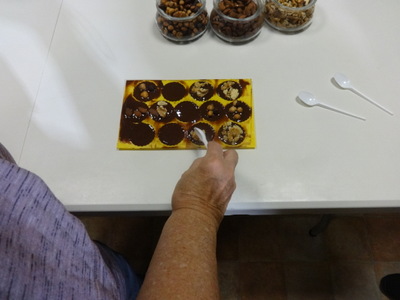
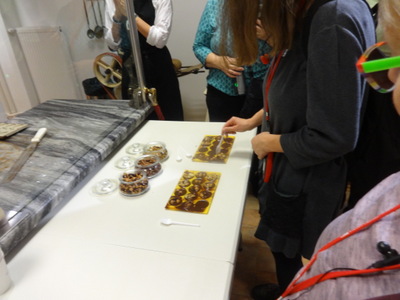 Our only contribution to the process was addition of whole nuts (from the little glass dishes visible in the photos) to the pastilles before they hardened. The two photos here show various members of our group doing so.
Our only contribution to the process was addition of whole nuts (from the little glass dishes visible in the photos) to the pastilles before they hardened. The two photos here show various members of our group doing so.
The guide then put the molds in the freezer to harden the chocolate while we browsed the shop downstairs. Before we left, she presented each of us with "our" pastilles, in little paper bags with the shop's seal. She warned us not to touch them while they were frozen. Strangely, she was right. If you touched one in the frozen state, chocolate instantly melted onto your fingers, but if you let them come to room temperature, it didn't! You could pick them up and handle them without melting. Very odd, that.
Things we learned on the ride back to the ship:
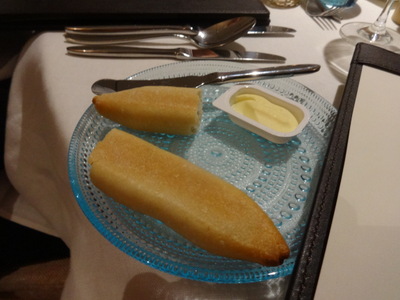
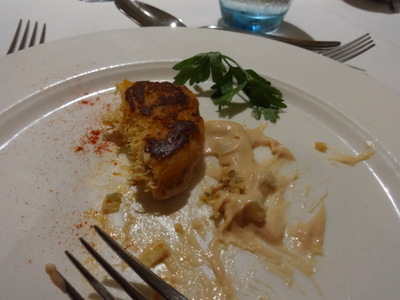 This was the meal intended to welcome (and impress) the new passengers. The bread of the evening was miniature baguettes.
This was the meal intended to welcome (and impress) the new passengers. The bread of the evening was miniature baguettes.
The pumpkin soup with pumpkin seed oil sounded good, but the crabcake with scallion remoulade sounded better, so that's what I started with.
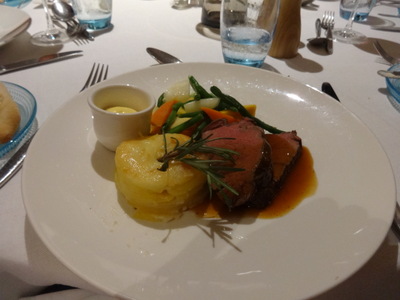
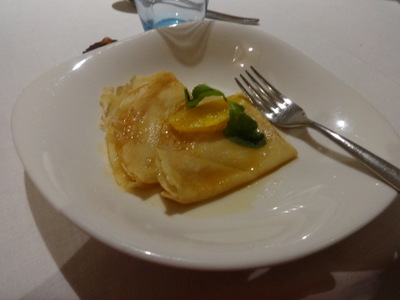 The vegetarian entrée also sounded good—lemon risotto with zucchini, burrata, and truffles—but not good enough to tempt us away from the other choice. I think we all ordered the chateaubriand with Béarnaise, gratin potato, and glazed vegetables. And darn good it was, too.
The vegetarian entrée also sounded good—lemon risotto with zucchini, burrata, and truffles—but not good enough to tempt us away from the other choice. I think we all ordered the chateaubriand with Béarnaise, gratin potato, and glazed vegetables. And darn good it was, too.
The dessert of Crêpes Suzettes with Grand Marnier caramel sauce was also very popular.
No special entertainment was planned for the evening—just George at the piano—so I retired to work on my diary.
Previous entry List of Entries Next entry